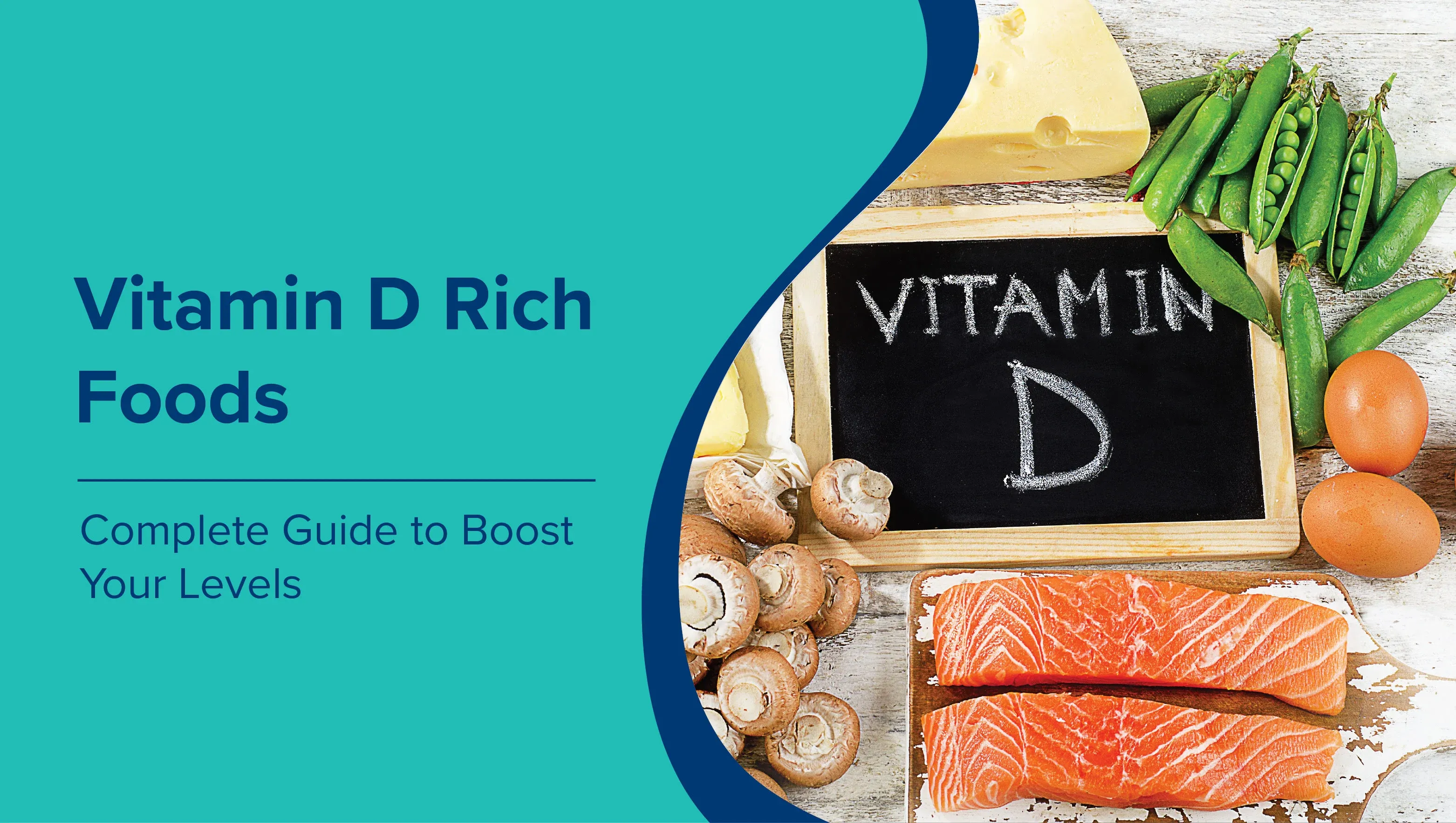Vitamin D deficiency is becoming increasingly common in India, affecting people across all age groups. This is largely due to limited outdoor activity, increasing pollution, and the use of sun protection - all of which reduce the skin’s ability to absorb UV rays and produce vitamin D. Over time, low levels of vitamin D can affect bone strength, immunity, and overall health. In such cases, incorporating vitamin D rich foods into daily meals is an effective way to bridge the gap, ensuring the body gets adequate support even when sun exposure is limited. In this article, we will explore some of the most effective vitamin D rich foods to maintain healthy levels, how to include them in your daily meals, and when testing or supplements might be necessary to maintain long-term health. But first, let’s understand the importance of Vitamin D in our body.
Why Vitamin D Is Important for the Body
Vitamin D plays a key role in maintaining bone health by helping the body absorb calcium and phosphorus from food. Adequate levels reduce the risk of rickets in children, osteoporosis in adults, and fractures in older age. It also supports immune function, enabling the body to fight infections more effectively, and contributes to healthy muscle strength and coordination. Beyond physical health, studies suggest Vitamin D may influence mood regulation and lower the risk of certain chronic diseases, making it an essential nutrient at every stage of life.
How Much Vitamin D Is Needed Daily?
The body’s primary natural source of Vitamin D is sunlight. When the skin is exposed to UVB rays, it triggers the production of Vitamin D3, the form most efficiently used by the body. Around 10–30 minutes of midday sun exposure, a few times a week, can help maintain healthy levels, although this can vary based on skin tone, clothing, season, and geographic location. The recommended daily intake of Vitamin D varies depending on age, lifestyle, and health status.
|
Group |
Recommended Daily Intake (IU) |
Recommended Daily Intake (µg) |
|
Infants, Children, and Adolescents |
400–600 IU |
10–15 µg |
|
Adults |
600–800 IU |
15–20 µg |
|
Pregnant and Breastfeeding Women |
600–800 IU or higher* |
15–20 µg or higher* |
|
Older Adults |
800 IU or slightly higher |
20 µg or slightly higher |
*Higher amounts may be advised by doctors in certain cases to support health needs.
Meeting these requirements through a combination of sunlight exposure, Vitamin D rich foods, and supplements (when prescribed) helps maintain optimal levels year-round.
Vitamin D Rich Foods List
Dietary sources provide important support, particularly when sun exposure is limited. Vitamin D can be obtained from a range of animal-based, vegetarian, and vegan foods. Including a variety of these in regular meals can help meet daily requirements and maintain healthy levels year-round.
Animal-Based Sources
-
Fatty fish such as salmon, mackerel, and sardines: among the richest natural sources of Vitamin D
-
Egg yolks: provide moderate amounts and are easy to add to meals
-
Cod liver oil: highly concentrated source often used as a supplement
-
Cheese: contains small amounts and can be paired with other Vitamin D foods
Vegetarian Sources
-
UV-exposed mushrooms: one of the few plant-based foods with natural Vitamin D
-
Fortified dairy products such as milk and yogurt: enriched to boost Vitamin D intake
-
Fortified cereals: convenient breakfast option with added Vitamin D
Fruits and Vegetables
Most fruits and vegetables do not naturally contain Vitamin D, but some fortified products, such as orange juice, may provide a useful boost.
Fortified Foods for Vitamin D
Fortification is an effective way to boost Vitamin D intake, particularly for those who follow vegetarian or vegan diets. These foods are enriched during processing to help meet daily nutritional needs without major dietary changes. Common fortified options include:
- Fortified milk and plant-based alternatives such as soy, almond, or oat milk
- Fortified breakfast cereals with added Vitamin D and other essential nutrients
- Fortified orange juice for those who prefer non-dairy options
- Fortified yogurt that combines calcium with Vitamin D for better bone health
Vitamin D Food Chart: Common Foods and Their Vitamin D Content
The table below provides an approximate idea of the Vitamin D content in common foods. Actual values may vary based on factors such as preparation method, brand, and fortification levels. (Note: 1 microgram (µg) of Vitamin D equals 40 International Units (IU)).
|
Food Item |
Serving Size |
Approx. Vitamin D Content (IU) |
|
Salmon (cooked) |
100 g |
526 IU |
|
Mackerel (cooked) |
100 g |
360 IU |
|
Sardines (canned) |
100 g |
272 IU |
|
Cod liver oil |
1 tsp |
450 IU |
|
Egg yolk |
1 large |
37 IU |
|
UV-exposed mushrooms |
100 g |
450 IU |
|
Fortified milk |
1 cup (250 ml) |
100 IU |
|
Fortified cereal |
1 serving |
80–100 IU |
|
Fortified orange juice |
1 cup (250 ml) |
100 IU |
|
Cheese (cheddar) |
100 g |
24 IU |
Can Food Alone Meet Your Vitamin D Needs?
While a balanced diet can provide a significant portion of the daily Vitamin D requirement, it is often difficult to meet the full amount from food alone. Factors such as limited natural food sources, seasonal changes, indoor lifestyles, and certain health conditions can make it challenging to maintain optimal levels through diet without additional support. Sunlight exposure remains an important contributor, but in many cases, a combination of dietary sources, sensible sun exposure, and supplements (when prescribed) is the most effective way to prevent deficiency.
Testing for Vitamin D Deficiency
When low Vitamin D levels are suspected, a blood test measuring serum 25-hydroxy vitamin D is the most reliable way to confirm deficiency. This test not only reveals current Vitamin D levels but also helps doctors assess whether the deficiency is mild, moderate, or severe. Based on the results, a healthcare provider can recommend the right approach, whether that means making dietary changes, increasing sun exposure, taking supplements, or starting medical treatment.
With MaxAtHome, testing becomes easier and more convenient, removing the need to visit a lab or clinic. We offer:
- Home sample collection by trained professionals
- Hygienic and safe procedures
- Timely processing at NABL-accredited labs for accurate results
- Detailed digital reports delivered promptly
- Trusted service with over 35 lakh patients served across India
To book a Vitamin D test at home, call 9240299624 or schedule the test online through our easy-to-use booking platform.
Frequently Asked Questions (FAQs)
Which food is highest in Vitamin D?
Fatty fish such as salmon, mackerel, and sardines are among the highest natural sources of Vitamin D. Cod liver oil also contains a very high concentration of Vitamin D per serving.
Which fruit has high Vitamin D?
Most fruits do not naturally contain Vitamin D. However, some fortified fruit juices, such as fortified orange juice, can help increase Vitamin D intake.
What are the best vegetarian sources of Vitamin D?
Vegetarian sources of Vitamin D include UV-exposed mushrooms, fortified dairy products like milk and yogurt, and fortified cereals. Plant-based milks such as soy or almond milk are also good options when fortified.
How can I increase Vitamin D levels quickly through diet?
Including Vitamin D rich foods such as fatty fish, egg yolks, fortified cereals, UV-exposed mushrooms, and fortified milk in daily meals can help. Pairing these foods with healthy fats improves absorption.
Can Vitamin D rich vegetables meet daily requirements?
Very few vegetables contain natural Vitamin D. Mushrooms exposed to sunlight are the only notable vegetable source. For most people, a combination of fortified foods, animal-based sources, and sunlight is needed.
What is the Vitamin D food chart used for?
A Vitamin D food chart lists common foods along with their Vitamin D content, making it easier to plan a diet that meets daily nutritional needs.
What are the symptoms of low Vitamin D levels?
Low Vitamin D can cause fatigue, muscle weakness, bone pain, and frequent illnesses. Severe deficiency may lead to rickets in children or osteoporosis in adults.
How is Vitamin D deficiency diagnosed?
A simple blood test, such as the Vitamin D test offered by MaxAtHome, measures 25-hydroxyvitamin D levels. This can be done through home sample collection for convenience and accuracy.
How can I book a Vitamin D test near me?
A Vitamin D test can be easily booked through MaxAtHome’s home collection service. Simply call 9240299624 or schedule the test online to arrange for a trained professional to collect the sample from your location. This service is available in multiple cities across India, making it convenient to get accurate results without searching for a lab near you.















